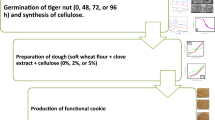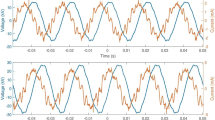Abstract
This study investigated the types and concentrations of binders on the physical and antioxidant properties of pelleted sweet corn seeds. Three types of binders at various concentrations (% w/v) were used: carrageenan at 0.1, 0.2 and 0.3; gelatin at 1, 2 and 3%; and gum arabic 0.01, 0.03 and 0.05. The storage periods were 0, 1, 2, 3 and 4 months. The physical properties and qualities of unpelleted and pelleted seeds with non-ionic polyacrylamide (PAM, 5% w/v) were evaluated and compared. The results showed that all three binders were better in pelleting integrity than PAM. Throughout the 4 months’ storage period, pelleted seeds with gum arabic of 0.01% w/v showed that their germination index, seedling growth and shoot growth rates were higher than in unpelleted seeds. The highest amount of anthocyanins, phenolics, carotenoids and the levels of the antioxidant capacities determined by the ferric-reducing antioxidant power, 1,1-diphenyl-2-picrylhydrazyl, and 2, 2-azino-bis (3-ethyl-benzothiazoline-6-sulfonic acid) diammonium salt assays were found in pelleted seeds with gum arabic of 0.01% w/v. The overall quality of seeds depends on their treatment.



Similar content being viewed by others
References
Xiang N, Guo X, Liu F, Li Q, Hu J, Brennan CS (2017) Effect of light- and dark-germination on the phenolic biosynthesis, phytochemical profiles, and antioxidant activities in sweet corn (Zea mays L.) sprouts. Int J Mol Sci 18(6):1246 (ISSN: 1422-0067)
Styer RC, Cantliffe DJ, Hannan LC (1980) Differential seed and seedling vigor in shrunken-2 compared to three other genotypes of corn at various stages of development. J Am Soc Hortic Sci 105:329–332
Parera CA, Cantliffe DJ (1994) Presowing seed treatments to enhance super sweet corn seed and seedling quality. HortScience 29:277–278
Parera CA, Cantliffe DJ, Stoffella PJ, Scully BT (1995) Field emergence of shrunken 2 corn predicted by single and multiple vigor in laboratory tests. J Am Soc Hortic Sci 120:128–132
Taylor AG, Harman GE (1990) Concepts and technologies of selected seed treatments. Annu Rev Phytopathol 28:321–339
Kreeppha L (2009) Effect of physical properties of pelleting material on quality of sweet corn seed. Master thesis (Agronomy). Chiang Mai University
Boonmala N (2013) Effects of pelleted sweet corn seed by using urea formaldehyde slow release fertilizer. Master thesis (Agronomy). Chiang Mai University
Garcia-Saldana JS, Campas-Baypoli ON, Lopez-Cervantes J, Sanchez-Machado DI, Cantu-Soto EU, Rodriguez-Ramirez R (2016) Microencapsulation of sulforaphane from broccoli seed extracts by gelatin/gum arabic and gelatin/pectin complexes. Food Chem 201:94–100
Mahdavi SA, Jafari SM, Assadpoora E, Dehnada D (2016) Microencapsulation optimization of natural anthocyanins with maltodextrin, gum arabic and gelatin. Int J Biol Macromol 85:379–385
Anvari M, Chung D (2016) Effect of cooling-heating rate on sol-gel transformation of fish gelatin-gum arabic complex coacervate phase. Int J Biol Macromol 91:450–456
Rattanapanone N (2010) Food chemistry, 4th edn. Publisher Odien store, Bangkok, p 504
International Seed Testing Association (ISTA) (2006) International rules for seed testing, seed science and technology. The International Seed Testing Association, Bassersdorf, p 540
Association of Official Seed Analysts (AOSA) (2009) Seedling evaluation handbook. Contribution. No. 35. Association of Official Seed Analysts, Lincoln, pp 20–73
Park YS, Im MH, Choi JH, Yim SH, Leontowicz H, Leontowicz M, Suhaj M, Gorinstein S (2013) The effects of ethylene treatment on the bioactivity of conventional and organic growing ‘Hayward’ kiwi fruit. Sci Hortic 164:589–595
Singleton VL, Orthofer R, Lamuela-Raventos RM (1999) Analysis of total phenols and other oxidation substrates and antioxidants by means of Folin–Ciocalteu reagent. Methods Enzymol 299:152–158
Cheng GW, Breen PJ (1991) Activity of phenylalanine ammonialyase (PAL) and concentrations of anthocyanins and phenolics in developing strawberry fruit. J Am Soc Hortic Sci 116:865–869
Boyer RF (1990) Isolation and spectrophotometric characterization of photosynthetic pigments. Biochem Educ 18:203–206
Re R, Pellegrini N, Proteggente A, Pannala A, Yang M, Rice-Evans C (1999) Antioxidant activity applying an improved ABTS radical cation decolorization assay. Free Radic Biol Med 26:1231–1237
Benzie IFF, Strain JJ (1996) The ferric reducing ability of plasma (FRAP) as a measure of antioxidant power: the FRAP assay. Anal Biochem 239:70–76
Brand-Williams W, Cuvelier ME, Berset C (1995) Use of a free radical method to evaluate antioxidant activity. Food Sci Technol 28:25–30
Yaja J (2004) Predicting the viability and quality of soybean seed in relationship of seed moisture and temperature in storage. Master’s Thesis (Agronomy), Chiang Mai University
Delouche JC, Baskin CC (1973) Accelerated aging techniques for predicting the relative storability of seed lots. Seed SciTech 1:427–452
Kang JS, Son BC, Choi YW, Lee YJ, Park YH, Choi IS (2007) Effect of physical, chemical properties and pelleting solid materials on the germination in pelleted carrot seeds. Kor J Life Sci 17:1701–1708
Doungpatra C (1986) Seed technology, 2nd edn. Department of Agronomy, Faculty of Agriculture, Kasetsart University, Bangkok, p 210
Hirota H (1972) Studies of surface sowing in grassland establishment with use of pelleted seeds. Grassland Sci 18:299–309
Kabbai S (2009) Influence of oxygen donor from seed pelleting material on germination of sweet corn. Master thesis (Agronomy). Chiang Mai University
Roos EE, Moore FD (1975) The effect of seed coating on performance of lettuce seeds in greenhouse soil tests. J Am Soc Hortic Sci 100:573–576
Ratchakom W, Boonmala N, Khunkeaw S, Sawadeemit C, Vearasilp S, Thanapornpoonpong S (2012) Effects of adding mixtures of urea and polyethylene glycol on the quality of sweet corn pelleted seed. Agric Sci J 43(3 Suppl.):649652
Somrat N, Ratchakom W, Sawadeemit C, Vearasilp S, Thanapornpoonpong S (2013) The comparison of types and various concentrations of hydrocolloids on physical properties and qualities of pelleted sweet corn seed. Agric Sci J 44(3 Suppl.):514–517
Nayak B, Liu RH, Tang J (2015) Effect of processing on phenolic antioxidants of fruits, vegetables, and grains—a review. Crit Rev Food Sci Nutr 55:887–919
Hu Q-P, Xu J-G (2011) Profiles of carotenoids, anthocyanins, phenolics, and antioxidant activity of selected color waxy corn grains during maturation. J Agric Food Chem 59:2026–2033
Author information
Authors and Affiliations
Corresponding authors
Ethics declarations
Conflict of interest
The authors declare that they have no conflict of interest.
Compliance with ethics requirements
This article does not contain any studies with human or animal subjects.
Informed consent
Informed consent was obtained from all individual participants included in the study.
Rights and permissions
About this article
Cite this article
Somrat, N., Sawadeemit, C., Vearasilp, S. et al. Effects of different binder types and concentrations on physical and antioxidant properties of pelleted sweet corn seeds. Eur Food Res Technol 244, 547–554 (2018). https://doi.org/10.1007/s00217-017-2979-y
Received:
Revised:
Accepted:
Published:
Issue Date:
DOI: https://doi.org/10.1007/s00217-017-2979-y




